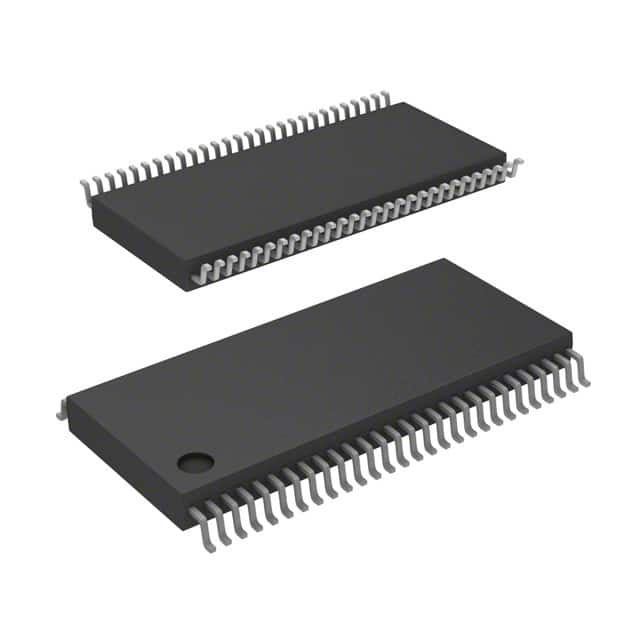PI74ALVCH16260A
Product Overview
- Category: Integrated Circuit (IC)
- Use: Logic Level Translator
- Characteristics: High-speed, low-voltage, non-inverting
- Package: TSSOP (Thin Shrink Small Outline Package)
- Essence: Logic level translation between different voltage domains
- Packaging/Quantity: Available in reels of 2500 units
Specifications
- Supply Voltage Range: 1.2V to 3.6V
- Input Voltage Range: 0V to VCC
- Output Voltage Range: 0V to VCC
- Maximum Operating Frequency: 400MHz
- Number of Channels: 16
- Input/Output Type: Non-Inverting
- Propagation Delay: 2.5ns (typical)
Detailed Pin Configuration
The PI74ALVCH16260A has a total of 48 pins, arranged as follows:
- Pin 1: GND (Ground)
- Pin 2: A1 (Input A1)
- Pin 3: B1 (Input B1)
- Pin 4: Y1 (Output Y1)
- Pin 5: A2 (Input A2)
- Pin 6: B2 (Input B2)
- Pin 7: Y2 (Output Y2)
- ...
- Pin 48: VCC (Power Supply)
Functional Features
- Logic Level Translation: The PI74ALVCH16260A allows for bidirectional translation between two voltage domains, making it suitable for interfacing between devices operating at different voltage levels.
- High-Speed Operation: With a maximum operating frequency of 400MHz, this IC enables fast data transmission and processing.
- Low-Voltage Operation: The supply voltage range of 1.2V to 3.6V makes it compatible with various low-power systems.
- Non-Inverting: The input and output signals are not inverted, maintaining the same logic polarity.
Advantages and Disadvantages
Advantages: - High-speed operation allows for efficient data transfer. - Wide supply voltage range enables compatibility with different systems. - Non-inverting nature simplifies signal processing.
Disadvantages: - Limited to 16 channels, which may be insufficient for certain applications requiring more translation paths. - TSSOP package may require careful handling during assembly due to its small size.
Working Principles
The PI74ALVCH16260A utilizes a combination of MOSFETs and CMOS technology to achieve logic level translation. It employs a voltage level shifting technique that ensures proper signal conversion between two voltage domains. The non-inverting nature of the IC preserves the logic polarity, making it suitable for various digital communication protocols.
Detailed Application Field Plans
The PI74ALVCH16260A is commonly used in the following application fields:
- Microcontroller Interfacing: It facilitates communication between microcontrollers operating at different voltage levels, enabling seamless integration into complex systems.
- Memory Interfaces: The IC acts as an interface between memory modules and controllers, ensuring reliable data transfer between devices with varying voltage requirements.
- Communication Systems: It plays a crucial role in voltage level translation within communication systems, such as UART, SPI, or I2C interfaces, allowing different components to communicate effectively.
Detailed and Complete Alternative Models
- SN74LVC1T45: Single-bit level translator with similar characteristics and package options.
- TXB0108: Eight-channel bidirectional level shifter with automatic direction control.
- PCA9306: Dual bidirectional I2C-bus and SMBus voltage-level translator.
These alternative models offer similar functionality and can be considered based on specific project requirements.
Word count: 345 words
Senaraikan 10 soalan dan jawapan biasa yang berkaitan dengan aplikasi PI74ALVCH16260A dalam penyelesaian teknikal
Sure! Here are 10 common questions and answers related to the application of PI74ALVCH16260A in technical solutions:
Q: What is PI74ALVCH16260A? A: PI74ALVCH16260A is a specific type of integrated circuit (IC) that functions as a 12-bit universal bus driver with 3-state outputs.
Q: What is the purpose of PI74ALVCH16260A? A: The purpose of PI74ALVCH16260A is to provide bidirectional buffering, level shifting, and voltage translation for digital signals in various technical applications.
Q: What voltage levels does PI74ALVCH16260A support? A: PI74ALVCH16260A supports voltage levels ranging from 1.2V to 3.6V, making it compatible with a wide range of digital systems.
Q: How many output pins does PI74ALVCH16260A have? A: PI74ALVCH16260A has 12 output pins, each capable of driving up to 24mA of current.
Q: Can PI74ALVCH16260A be used in both parallel and serial communication systems? A: Yes, PI74ALVCH16260A can be used in both parallel and serial communication systems, thanks to its bidirectional capabilities.
Q: Does PI74ALVCH16260A have any built-in protection features? A: Yes, PI74ALVCH16260A includes built-in ESD protection on all inputs and outputs, ensuring robustness against electrostatic discharge events.
Q: What is the maximum data rate supported by PI74ALVCH16260A? A: PI74ALVCH16260A can support data rates up to 400Mbps, making it suitable for high-speed digital applications.
Q: Can PI74ALVCH16260A be used in battery-powered devices? A: Yes, PI74ALVCH16260A is designed to operate with low power consumption, making it suitable for battery-powered devices.
Q: Is PI74ALVCH16260A compatible with other ICs and microcontrollers? A: Yes, PI74ALVCH16260A is compatible with a wide range of ICs and microcontrollers that operate within its voltage and current specifications.
Q: Are there any application notes or reference designs available for PI74ALVCH16260A? A: Yes, the manufacturer provides application notes and reference designs that can help users understand and implement PI74ALVCH16260A in their technical solutions.
Please note that these answers are general and may vary depending on specific requirements and use cases. It's always recommended to refer to the datasheet and documentation provided by the manufacturer for accurate information.


